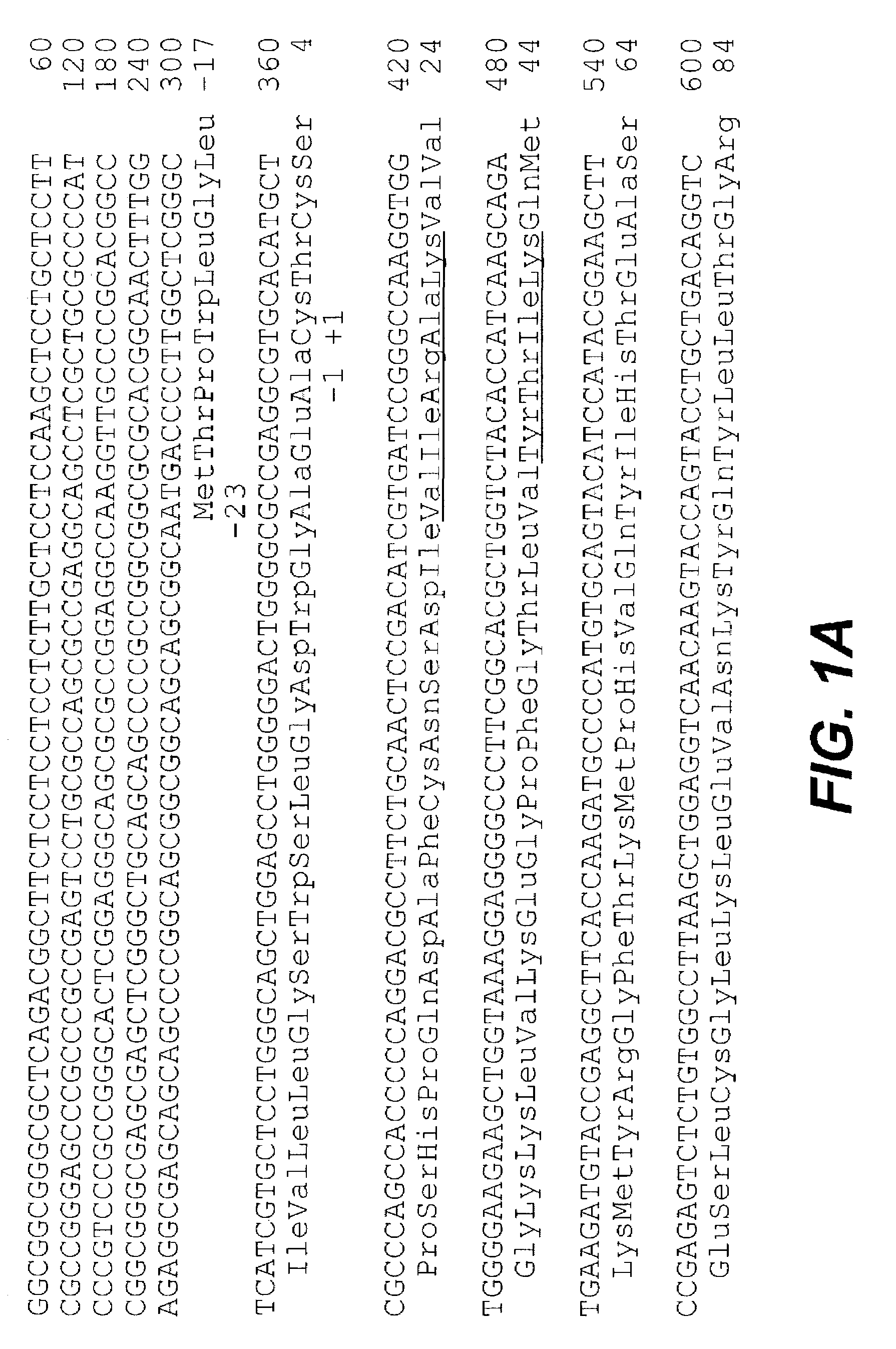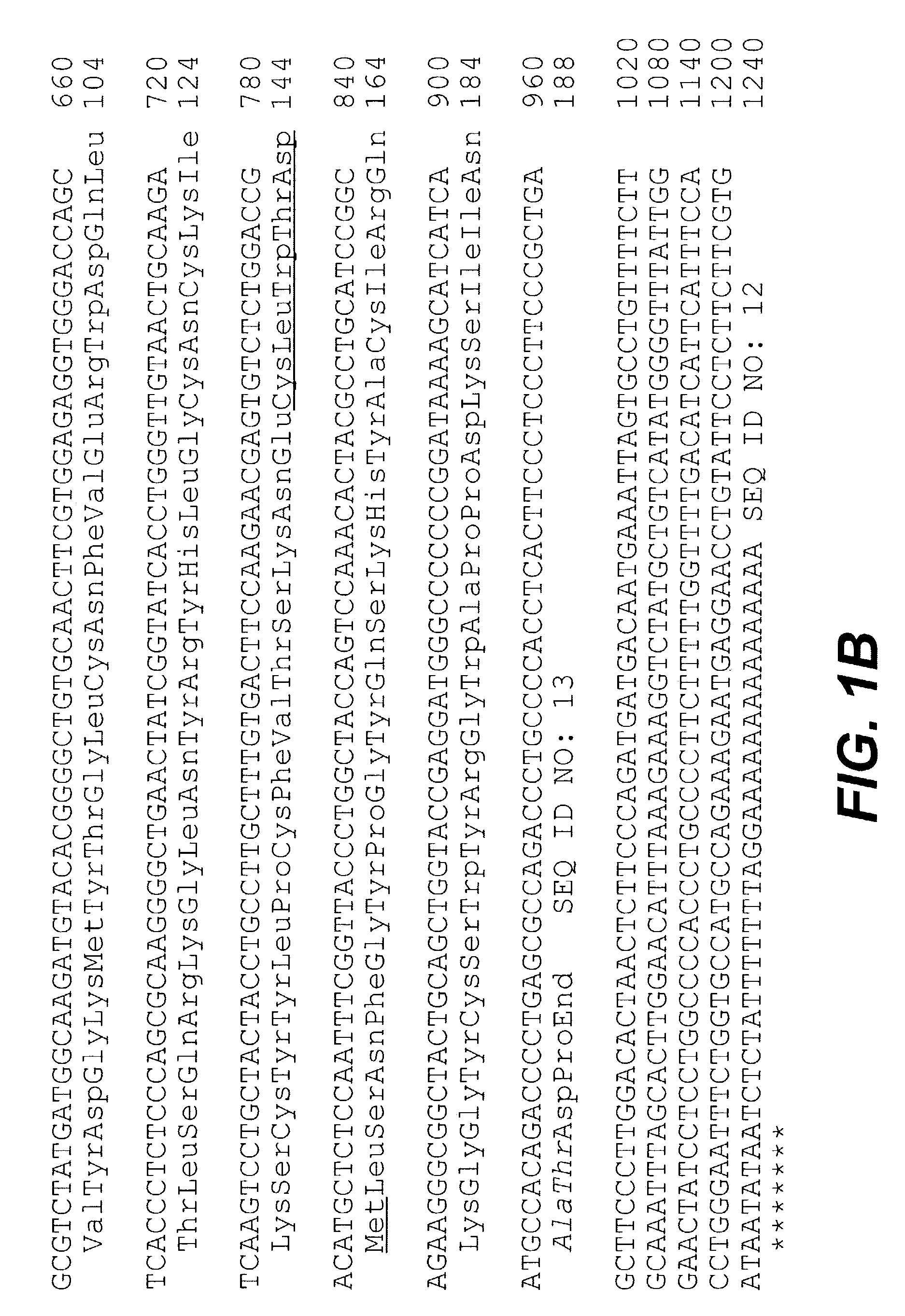Tissue inhibitor of metalloproteinase type three (TIMP-3) composition and methods
a technology of metalloproteinase and composition, applied in the field of tissue inhibitors of metalloproteinase type three (timp-3) composition and methods, can solve the problem of limited measurement of metalloproteinases to collagenas
- Summary
- Abstract
- Description
- Claims
- Application Information
AI Technical Summary
Benefits of technology
Problems solved by technology
Method used
Image
Examples
example 1
Cloning and Expression of Human TIMP-3 cDNA
[0089]The overall cloning strategy involved two steps, the first, obtaining a fragment using PCR from a human fetal kidney cDNA library, and the second, using this partial clone to screen two different cDNA libraries for full length cDNA sequences.
[0090]Degenerate PCR primers derived from highly conserved regions of the TIMP gene family were used to amplify TIMP-3 cDNA from human fetal kidney cDNA. This product was then used as a probe to isolate clones from a human fetal kidney cDNA library and a normal human colonic mucosa cDNA library. Clones of 1240, 963 and 827 bp have been isolated and sequenced. The longest clone encodes the entire 211 amino acid pro-polypeptide, having a mature polypeptide of 188 amino acids. The intermediate size clone is truncated but encodes the entire mature protein. The smallest clone is missing the region encoding the first 24 amino acids of the mature polypeptide. Also demonstrated is the expression and purif...
example 2
Expression of TIMP-3 in Various Cell Types
[0170]A variety of cells were tested for the expression of TIMP-3 RNA (which would indicate polypeptide expression). The results show that among normal (i.e., non-cancerous) cells, expression is observed in cells associated with extracellular matrix activity (i.e., growth of degradation). The normal cells (or tissues) where TIMP-3 RNA expression was seen (FIGS. 14A and B) are placenta, stromal cells, embryonic lung, newborn foreskin (one of two samples being slightly positive), and (slightly positive) adult lung. Among the cancer cells tested, some were positive, some were negative. For example, various breast adenocarinoma cell lines yielded disparate results; with one was positive, one was negative, one was slightly positive. This may indicate temporal expression, in that TIMP-3 expression may vary over the course of disease progression, although the significance is unclear. Table 2, below, presents a description of the cells tested and th...
example 3
In Vitro Activity of Human Recombinant TIMP-3
Modified Zymogram
[0183]DeClerck et al. J. Biol. Chem. 2: 17445–17453 (1991) showed that TIMP-2 will bind to pAPMA-activated rabbit fibroblast interstitial collagenase in complexes that are stable in SDS. The 52 kDa inactive presursor was cleaved to an active 42 kDa protein by the organomercurial. Although the active protein primarily degrades type I, II and III collagen, it will also degrade gelatin to a lesser degree.
[0184]Conditioned medium (CM) from rabbit synovial fibroblasts contains interstitial collagenase as well as 72 kDa type IV gelatinase. The CM was incubated in 5 μl of 50 mM Tris-HCl, 200 mM NaCl, 10 mM CaCl2, pH 7.5 for 15 minutes in either the presence or absence of TIMP-2 (according to EP 0 398 753), TIMP-2Δ or the FIG. 1 TIMP-3. Note that TIMP-2Δ refers to a trucated biologically active form of TIMP-2 with amino acids 128–194 of the mature protein deleted. Tolley et al., J. Mol. Biol. 229: 1163–1164(1993); Willenbrock et ...
PUM
| Property | Measurement | Unit |
|---|---|---|
| pH | aaaaa | aaaaa |
| pH | aaaaa | aaaaa |
| volume | aaaaa | aaaaa |
Abstract
Description
Claims
Application Information
 Login to View More
Login to View More - R&D
- Intellectual Property
- Life Sciences
- Materials
- Tech Scout
- Unparalleled Data Quality
- Higher Quality Content
- 60% Fewer Hallucinations
Browse by: Latest US Patents, China's latest patents, Technical Efficacy Thesaurus, Application Domain, Technology Topic, Popular Technical Reports.
© 2025 PatSnap. All rights reserved.Legal|Privacy policy|Modern Slavery Act Transparency Statement|Sitemap|About US| Contact US: help@patsnap.com



